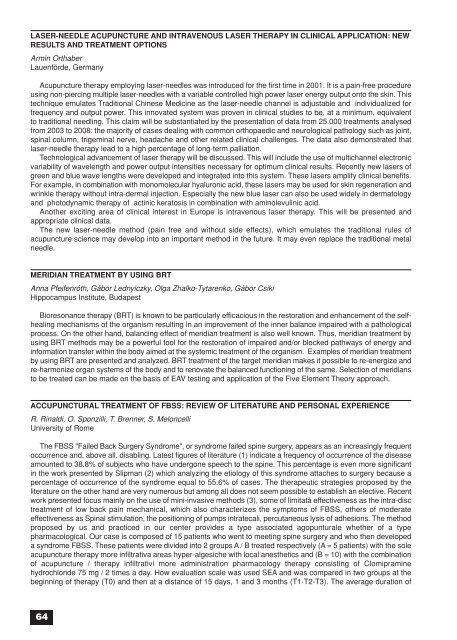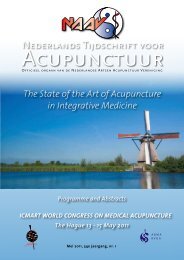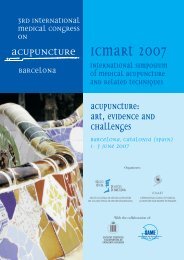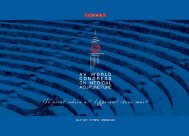Congress Abstracts full PDF - International Council of Medical ...
Congress Abstracts full PDF - International Council of Medical ...
Congress Abstracts full PDF - International Council of Medical ...
Create successful ePaper yourself
Turn your PDF publications into a flip-book with our unique Google optimized e-Paper software.
LASER-NEEDLE ACUPUNCTURE AND INTRAVENOUS LASER THERAPY IN CLINICAL APPLICATION: NEW<br />
RESULTS AND TREATMENT OPTIONS<br />
Armin Orthaber<br />
Lauenförde, Germany<br />
Acupuncture therapy employing laser-needles was introduced for the first time in 2001. It is a pain-free procedure<br />
using non-piercing multiple laser-needles with a variable controlled high power laser energy output onto the skin. This<br />
technique emulates Traditional Chinese Medicine as the laser-needle channel is adjustable and individualized for<br />
frequency and output power. This innovated system was proven in clinical studies to be, at a minimum, equivalent<br />
to traditional needling. This claim will be substantiated by the presentation <strong>of</strong> data from 25.000 treatments analysed<br />
from 2003 to 2008: the majority <strong>of</strong> cases dealing with common orthopaedic and neurological pathology such as joint,<br />
spinal column, trigeminal nerve, headache and other related clinical challenges. The data also demonstrated that<br />
laser-needle therapy lead to a high percentage <strong>of</strong> long-term palliation.<br />
Technological advancement <strong>of</strong> laser therapy will be discussed. This will include the use <strong>of</strong> multichannel electronic<br />
variability <strong>of</strong> wavelength and power output intensities necessary for optimum clinical results. Recently new lasers <strong>of</strong><br />
green and blue wave lengths were developed and integrated into this system. These lasers amplify clinical benefits.<br />
For example, in combination with monomolecular hyaluronic acid, these lasers may be used for skin regeneration and<br />
wrinkle therapy without intra-dermal injection. Especially the new blue laser can also be used widely in dermatology<br />
and photodynamic therapy <strong>of</strong> actinic keratosis in combination with aminolevulinic acid.<br />
Another exciting area <strong>of</strong> clinical interest in Europe is intravenous laser therapy. This will be presented and<br />
appropriate clinical data.<br />
The new laser-needle method (pain free and without side effects), which emulates the traditional rules <strong>of</strong><br />
acupuncture science may develop into an important method in the future. It may even replace the traditional metal<br />
needle.<br />
MERIDIAN TREATMENT BY USING BRT<br />
Anna Pfeifenróth, Gábor Lednyiczky, Olga Zhalko-Tytarenko, Gábor Csiki<br />
Hippocampus Institute, Budapest<br />
Bioresonance therapy (BRT) is known to be particularly efficacious in the restoration and enhancement <strong>of</strong> the selfhealing<br />
mechanisms <strong>of</strong> the organism resulting in an improvement <strong>of</strong> the inner balance impaired with a pathological<br />
process. On the other hand, balancing effect <strong>of</strong> meridian treatment is also well known. Thus, meridian treatment by<br />
using BRT methods may be a powerful tool for the restoration <strong>of</strong> impaired and/or blocked pathways <strong>of</strong> energy and<br />
information transfer within the body aimed at the systemic treatment <strong>of</strong> the organism. Examples <strong>of</strong> meridian treatment<br />
by using BRT are presented and analyzed. BRT treatment <strong>of</strong> the target meridian makes it possible to re-energize and<br />
re-harmonize organ systems <strong>of</strong> the body and to renovate the balanced functioning <strong>of</strong> the same. Selection <strong>of</strong> meridians<br />
to be treated can be made on the basis <strong>of</strong> EAV testing and application <strong>of</strong> the Five Element Theory approach.<br />
ACCUPUNCTURAL TREATMENT OF FBSS: REVIEW OF LITERATURE AND PERSONAL EXPERIENCE<br />
R. Rinaldi, O. Sponzilli, T. Brenner, S. Meloncelli<br />
University <strong>of</strong> Rome<br />
The FBSS "Failed Back Surgery Syndrome", or syndrome failed spine surgery, appears as an increasingly frequent<br />
occurrence and, above all, disabling. Latest figures <strong>of</strong> literature (1) indicate a frequency <strong>of</strong> occurrence <strong>of</strong> the disease<br />
amounted to 38.8% <strong>of</strong> subjects who have undergone speech to the spine. This percentage is even more significant<br />
in the work presented by Slipman (2) which analyzing the etiology <strong>of</strong> this syndrome attaches to surgery because a<br />
percentage <strong>of</strong> occurrence <strong>of</strong> the syndrome equal to 55.6% <strong>of</strong> cases. The therapeutic strategies proposed by the<br />
literature on the other hand are very numerous but among all does not seem possible to establish an elective. Recent<br />
work presented focus mainly on the use <strong>of</strong> mini-invasive methods (3), some <strong>of</strong> limitatà effectiveness as the intra-disc<br />
treatment <strong>of</strong> low back pain mechanical, which also characterizes the symptoms <strong>of</strong> FBSS, others <strong>of</strong> moderate<br />
effectiveness as Spinal stimulation, the positioning <strong>of</strong> pumps intratecali, percutaneous lysis <strong>of</strong> adhesions. The method<br />
proposed by us and practiced in our center provides a type associated agopunturale whether <strong>of</strong> a type<br />
pharmacological. Our case is composed <strong>of</strong> 15 patients who went to meeting spine surgery and who then developed<br />
a syndrome FBSS. These patients were divided into 2 groups A / B treated respectively (A = 5 patients) with the sole<br />
acupuncture therapy more infiltrativa areas hyper-algesiche with local anesthetics and (B = 10) with the combination<br />
<strong>of</strong> acupuncture / therapy infiltrativi more administration pharmacology therapy consisting <strong>of</strong> Clomipramine<br />
hydrochloride 75 mg / 2 times a day. How evaluation scale was used SEA and was compared in two groups at the<br />
beginning <strong>of</strong> therapy (T0) and then at a distance <strong>of</strong> 15 days, 1 and 3 months (T1-T2-T3). The average duration <strong>of</strong><br />
64







